This is a review for the Ohio Deadlift Bar from Rogue Fitness – an extra long, highly elastic power bar designed exclusively for heavy deadlifts. A bar that I think the majority of you will agree rivals both the Okie Deadlift Bar and Texas Deadlift Bar not only in specifications, but also in price.
Updated January 2018 – checked for price and detail accuracy.
Ohio Deadlift Bar Review – Intro
Rogue Fitness went from hinting about making a deadlift bar to actually releasing the Ohio Deadlift Bar much quicker than most of us expected. A very nice surprise indeed. The quick turn-around appears to be largely due to the amount of research, development, and testing that went into creating the Rogue Elephant Bar; a custom 9-foot long beast of a deadlift bar that was used for the 2016 Arnold Strongman Classic. Having to build a deadlift bar tough enough to handle all of the strongest men on the planet (and in time for the Arnold) seems to have fast-tracked the Ohio.
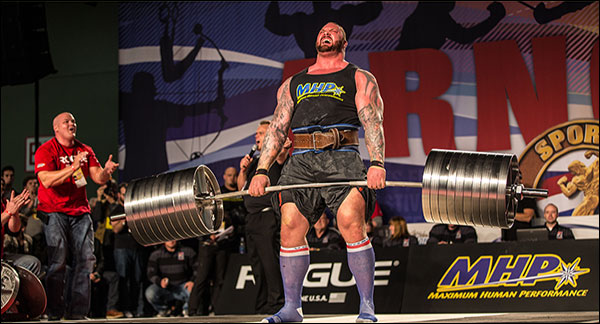
Rogue Elephant Bar debut at the 2016 Arnold Strongman Classic. Before you get excited, the Elephant was only for the Arnold – it cannot be purchased, and neither can those killer Schwarzenegger plates.
There are two variants of the Ohio Deadlift Bar and both sold out almost immediately upon being released, but thanks to my savvy skills and quick mouse clicking I was able to secure my deadlift bar on the day it was released (I signed up for email alerts and happened to be at the computer when I got it – not so savvy really).
In any case, I am now the proud owner of a bare steel Ohio Deadlift Bar, and I am happy to be able to give you all of the important details before the next batch is released so that you can be an informed shopper. I will also be providing a chart towards the bottom of the page showing you how the Ohio compares to the Texas Deadlift Bar and the Okie Deadlift Bar.
Ohio Deadlift Bar Specifications
- 20 kg men’s deadlift bar
- Shaft diameter: 27 mm
- Length: 90.5″ (vs standard 86.5″)
- Sleeve assembly: cast bronze bushings/snap-ring
- Tensile strength rating: 190,000 PSI
- Elasticity: high elasticity/whip
- Knurl configuration: (IPF) power markings with no center
- Knurl depth: very aggressive (same as Ohio Power Bar)
- Loadable sleeve Length: 15.5″
- Finish: raw steel or zinc
- Price: $295 – $355 (bare/zinc)
- Manufactured in Ohio, USA – lifetime warranty

Ohio Power Bar vs Ohio Deadlift Bar
While Rogue’s Ohio Power Bar and Rogue Ohio Deadlift Bar both share the same name as well as many similarities, they are about as different as they are alike. Among the attributes that they share, they are both bronze bushing bars built around a 190k PSI shaft, they have the same knurl pattern, and both are offered in the same finish options (the Ohio Power Bar is now offered in stainless steel while the Deadlift is not [yet]). So what’s not the same?
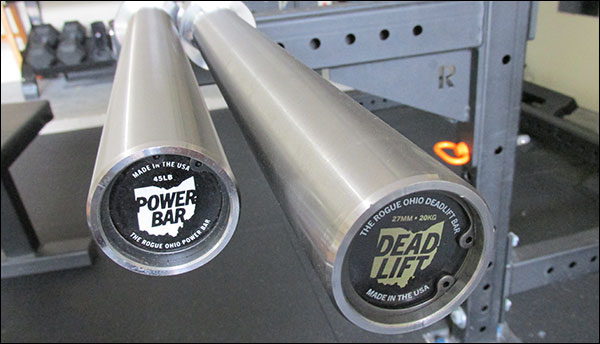
For starters, the shaft diameter of the Ohio Deadlift Bar is 27 mm rather than 29 mm. That’s a significant difference in diameter that anyone will be able to feel no matter how big or tiny their hands are. The purpose of this narrow shaft is primarily to allow for more flexibility, but there is also the side-effect of making the shaft slightly easier (perhaps even much easier) to hold on to.
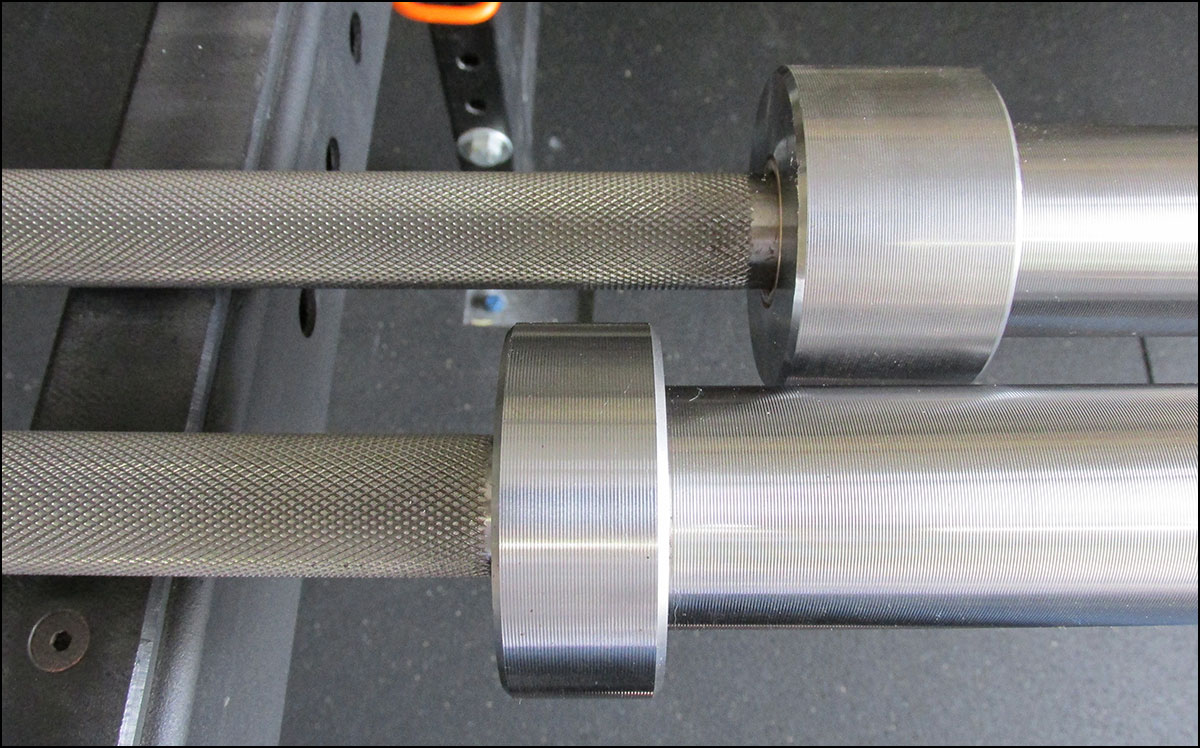
The differences in shaft diameter, shoulder width, and overall length are pretty easy to spot at a quick glance (click to enlarge.)
Another noticeable difference is the total length of the Ohio Deadlift Bar. It’s about 4″ longer than the standard Ohio (90.5″ in length versus 86.5″). Additionally, the distance between the sleeves is greater with the Ohio Deadlift, and the shoulders are wider, making the loadable sleeve length shorter. More specifically, there is 56″ between sleeves (vs 51.5″) and 15.5″ of loadable sleeve length (vs 16.25″). Just as with the smaller 27 mm shaft diameter, the point of this whole configuration is to enhance elasticity. Basically, the shaft is both narrower and longer, and the plates sit further away from the center of the bar.
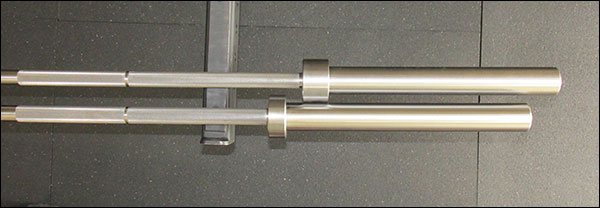
Both bars are lined up center to center (see hash marks) so you can see both the length difference and how far from the center of the bar that the plates sit on the sleeves.
Finally, the knurl of both bars is the same pattern but the depth is slightly different, which I’ll get more into below. Also there is no center knurl on the Ohio Deadlift Bar, but there is one on the Ohio Power.
Why all the Flex/Whip?
We hear time and time again that power bars are supposed to be strong, stiff bars with thick shafts and no flex. So if that’s the case why would anyone actually want a power bar that is not only skinny and whippy, but only intended for a single lift? The short answer is because people are under the impression that switching to a deadlift bar gets them an auto-increase to their 1-rep max. Is that true?
Deadlifting with a high-whip bar does offer some potential advantages, yes; the biggest of which is simply helping you off the floor. Given enough weight on the barbell, you will have pulled the slack out of the bar and moved through the first few inches of the lift before the weights have even broken the floor (image below). This means you’re in a stronger, more advantageous position by the time you’re pulling 100% of the weight. Also, because of this higher “starting position”, you now have a smaller distance that you have to pull the full load to lockout.
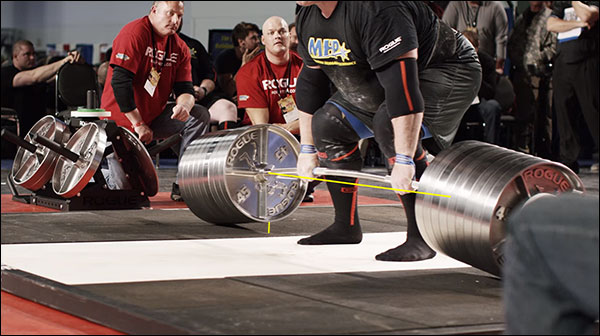
Here the bar is a good 3 or 4 inches up before the weight is even off of the floor.
I suppose another way to look at it would be to say that you’re progressively lifting the load while also reducing range of motion. Sure you still have to move through the same range to get from starting position to lock out, but if the first 3-4 inches off the floor “weighs” less by any amount whatsoever, wouldn’t that seem beneficial? Though it’s important to note that your current one-rep maximum deadlift needs to be rather heavy already for you to benefit from a deadlift bar. A 225-pound deadlift isn’t heavy enough to benefit from bar flex.
So the answer is yes, it’s true that you may be able to raise your deadlift 1RM by switching to a deadlift bar, but only if you already have a respectable max, and only if your weakness is in the hole rather than the lock out.
Now the question becomes: is it cheating to have the bar shaftcome up a number of inches before the plates break the floor? Is it even productive to your training? Well that’s for you to decide. I’m just explaining that the entire purpose of the skinny, narrow, high whip deadlift bar is to allow you to pull more weight than you would otherwise be able to pull with a super rigid bar. I can think of a couple reasons off the top of my head why this could be beneficial and detrimental, but I leave that up to you to decide based on your program and your goals.
Ohio Deadlift Bar Knurl
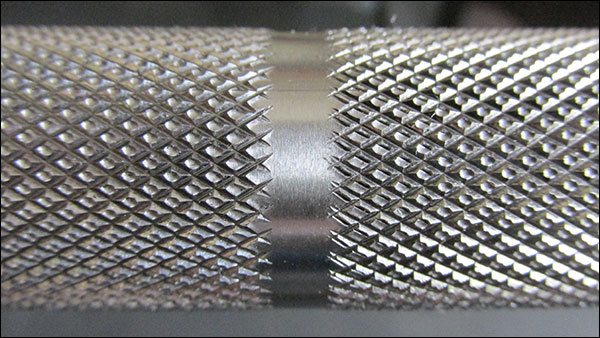
The knurl on the Ohio Deadlift is just a hint more aggressive than the standard Ohio Power Bar. Rogue actually mentions that it is the same pattern as the Ohio Power only with a hint more depth, which looks and feels about right to me. The thinner bar shaft also contributes greatly to the feeling of grip security. Truth be told, the knurl turned out perfect for the bar’s intended application. Very firm without being over the top.
The Deadlift Bar is marked the same as any power bar; IPF marks only. There is no center knurl on deadlift bars.
Ohio Deadlift – Sleeve Assembly/Rotation
It’s safe to say that if you’ve read one review for a Rogue bronze bushing bar, you’ve read them all. The sleeves of the Ohio Deadlift Bar has the typical pair of cast bronze bushings, solid assembly tolerances that keep lateral play down, and a snap ring to hold everything in place. Spin is typical of any Rogue bushing bar, and the only thing that’s really different is a slightly shorter overall loading length.
I do have one minor issue with the sleeve assembly though. But first, let me preface this by saying that I completely get it that the Ohio is not an Olympic WL or multi-purpose CrossFit bar, so it won’t be getting tossed around as such. That said, this bar is loud as hell to drop; maybe the loudest bar I’ve ever heard. Rogue bushing bars are not known for being quiet in the first place, but this one is noticeably louder. I don’t know if it has to do with having to make special bushings and sleeves just for this bar or what (Rogue’s only 27 mm bar), but it’s loud. There’s no excessive lateral play so I don’t know what gives.
Finish Options
Rogue Fitness offers the same finish options for the Ohio Deadlift as they do for the Ohio Power Bar; save for stainless steel (bare steel or black zinc shaft with bright zinc sleeves). As per usual, you can count on a better and more natural feel from the bare steel – not to mention a bar that ages with dignity and costs less.
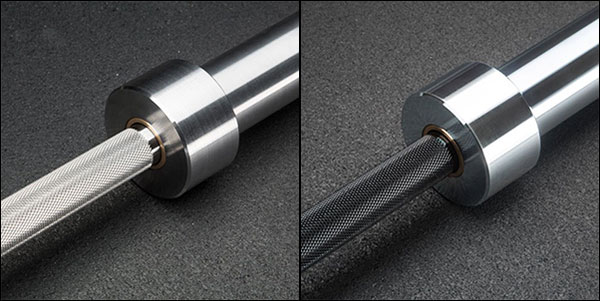
As I mentioned before, I ordered my bar (bare steel) minutes after Rogue released the Ohio Deadlift so I didn’t notice this, but I was told the bare steel version was completely sold out within an hour. Only after the bare steel was gone did the zinc fly off the shelves. It goes to show you that I’m not the only one to prefer raw metals versus finishes.
Is a Deadlift Bar For You?
I’ll be honest with you, if you’re a novice powerlifter with a 225 or less deadlift, a deadlift bar is probably a poor use of your funds. Whippy as it may be compared to a 29 mm power bar, there needs to be some weight on the bar to see much of a difference between them. That is to say, a deadlift bar will still feel pretty rigid at lighter loads.
Having said that, there is one big advantage to a deadlift bar over the standard power bars regardless of your 1RM, and that is the 27 mm shaft. Holy crap does it feel good to pull with such a narrow shaft. That shaft diameter in combination with the Ohio’s deep sharp knurling is just incredible. Having both the Ohio Power Bar and Ohio Deadlift, and knowing that both share the same knurl pattern, I can still say without a doubt that 2 mm difference makes all the difference in the world.
So if you want to spend $300 for a narrow shaft despite having a relatively low deadlift, that is one thing. But if you think you’ll be adding weight for free just because it’s a flexible bar, you’ll be disappointed until your numbers go up.
Comparison Chart – Okie DL, Texas DL, Ohio DL
Below I’ve compared the core specifications for the Okie, Texas, and Ohio deadlift bar. The steel specifications (PSI tensile strength) for the Okie Deadlift Bar is not readily available so there can be no fair comparison made there. It is unlikely that it is any higher than the Ohio Deadlift Bar’s 190,000 PSI or Texas’ 186,000 PSI though, and even quite possible that it is actually lower.
| Okie | Texas | Ohio* | |
| Base Price | $399 | $399 | $275 |
| Est. Price Shipped | $460 | $460 | $300 |
| Weight | 20 kg | 20 kg | 20 kg |
| Length | 90-7/8″ | 90.5″ | 90.5″ |
| Shaft Diameter | 27 mm | 27 mm | 27 mm |
| Collar Distance | 55.5″ | 56″ | 56″ |
| Collar Width | 1-5/8″ | 2.5″ | 1-3/4″ |
| Loadable Length | 15.5″ | 14-3/4″ | 15.5″ |
| Finish | raw steel | zinc/raw | raw or zinc |
| Knurl | aggressive + | aggressive | aggressive + |
* Price for bare steel Ohio Deadlift Bar, as it is both the superior and more affordable variation.
The overall take-away from this comparison is that all three of these deadlift bars are similar in almost all regards. The two notable differences are that the TDB has unreasonably thick collars that lead to a shorter overall loadable sleeve length, and that the Rogue Deadlift Bar is significantly less expensive than the other two. Matter of fact, the Okie and Texas are not even competitive once you’ve paid for shipping (Rogue charges about $17-$25 to ship bars and the other two will run you $55-$65 for shipping.)
I’m not suggesting that you outright ignore the Okie Deadlift or Texas Deadlift based on the price alone, as there is something to said for the brands and their reputations. However, an up to $175 price difference is kind of a huge deal, and neither Okie or Buddy are giving you any more barbell than Rogue is for that money. On top of all of that you get to pick your bar finish with Rogue – that is assuming either is actually in stock.
Ohio Power Bar Review – Conclusion
I dig the Ohio if for no other reason than the feel of the bare steel, 27 mm shaft and super firm knurling. Even though I’m personally indifferent to the bonus weight from the whip (I do not compete), I can see replacing my standard power bar for deadlifts with the Ohio based on the feel of the shaft alone. It’s a nice addition.
Frankly, Rogue is killing it with their power bars; just shaming the usual manufacturers on price, specs, and options. All of the Ohio Power Bar variations are great additions that are offered at more than reasonable prices, and when you add in Rogue’s lower-than-average shipping costs for bars, stellar customer service, and lifetime warranties, it’s tough to find a reason to not buy Rogue power bars.
Do you need a deadlift bar though? Well that’s your call, but if you believe that you do, the Ohio Deadlift Bar should probably be the one you go with.
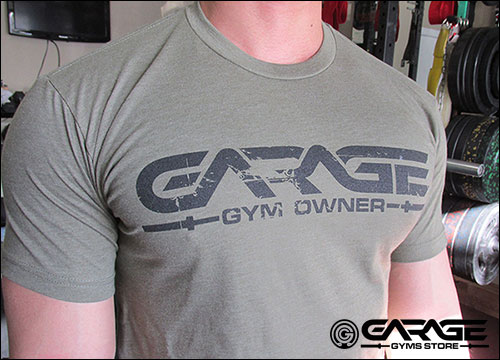

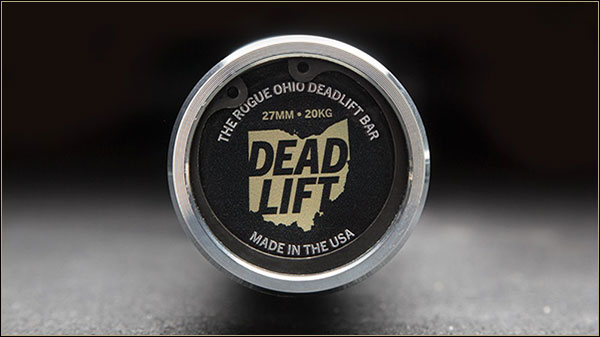
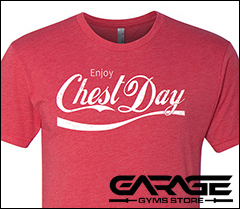
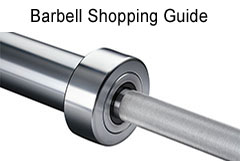
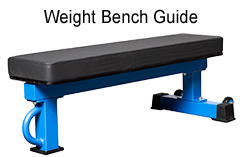
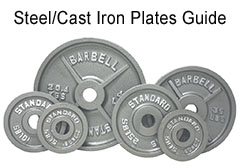
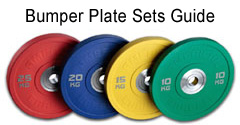
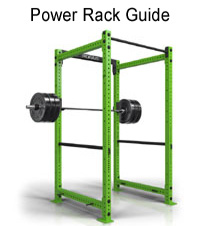
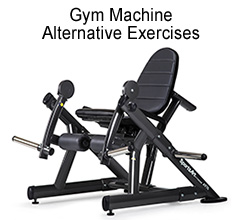

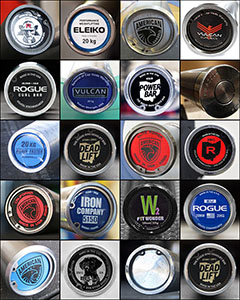

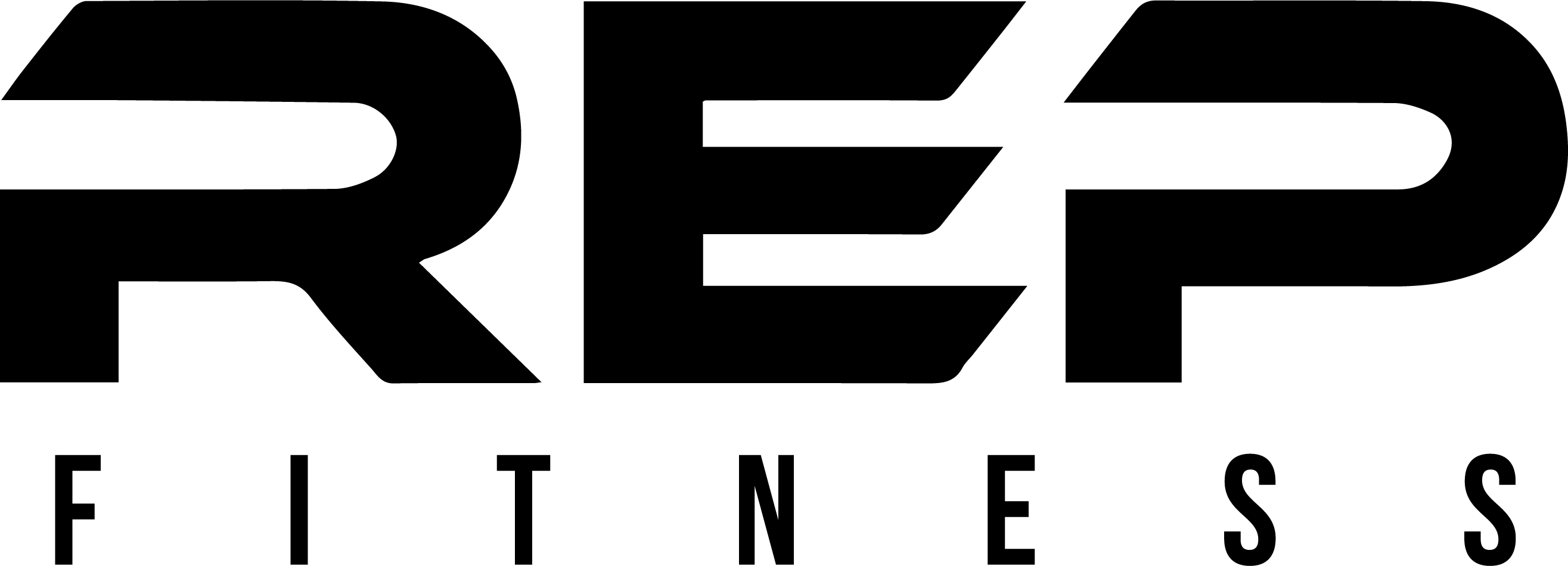
Thanks a million for this great write-up. The timing couldn’t have been better, as I’m pulling the trigger on finally choosing/ordering a deadlift bar next week. Probably leaning TDB, but the ODB looks pretty amazing. And, how cool were those custom plates at the Arnold?
Yeah those plates are just bad ass. I tried to drop a hint or two that I’d take a pair, and I don’t normally do shit like that, but that stuff doesn’t work with Rogue anyway so whatever haha. Maybe we’ll see them on eBay some day as the lucky recipients need cash =p
Someone must have done force-plate studies with these bars vs. less whippy ones — could be interesting. Even if the benefit (beyond the grip) is just in the depth and suddenness of the stress of that initial pull, it may make a significant difference to a lot of people in how well their body tolerates deadlifting a couple times a week while still training other lifts — or possibly allow them to deadlift a little more often.
Hope I can get my deadlift back to where I feel the need for one of these over my American Barbell Precision Training (28mm).
Thanks! Good, good stuff.
Yeah that is something I would be interested in seeing… most definitely.
Hi im from Korea So my english not good
I wanna understand my fool english to you
If you buy only one bar what do you buy? ( ohio power bar vs deadlift bar ) In my case, I like deadlift (my pr is 210kg) but I should do squat and else
I hope your reply
Thanks
If I were to buy only one bar, it would not be a deadlift bar. Ohio Power Bar is going to be more versatile.
How expensive is an Ohio Power Bar in Korea?!
Thanks!
Im just buy USD ( meaning is same price )
And I ask this product ship from USA to Korea
We have a lot of shiping company ( from USA to korea!)
Many Korean really like Rouge product ( bar shirt else )
That’s cool. Rogue EU and Canada are super expensive to shop from… almost does make more sense to buy for USD and pay a shipping company.
Thanks your kind
Your blog is really nice ! Perfect blog
Im so sorry one more qustion!!
Have you ever lift eleriko competition PL bar?
No actually, just about every Eleiko but the PL bar.
Thanks your kindness :)
Thanks for this review. I’m strongly considering picking up the stainless version once it becomes available. I would love to have just a pair of those custom Arnold plates. So awesome.
Yeah seriously – I’d like to know who ended up with all of those.
How has the bar held up?
I’ve got a Matt Chan bar now, would I benefit at all using the Deadlift bar with a 420lb max or should I continue using the Chan bar?
It’s a great bar. Holds up as well as any other Rogue bar.
420 is about enough to create some slack in the bar, and you’ll probably pull a little more right out of the gate with a deadlift bar than your Chan, but I’m not going to tell you it’ll change your world. 27 mm feels great for pulling, and it’ll get more interesting as that max goes up, but it’s not as though you have a bad bar that needs replacing. I recommend it, but I don’t want to overstate it since you already have a perfectly good bar.
Did I see somewhere that Rogue was offering the Ohio Deadlift bar in stainless or was that just the Ohio Power Bar?
I’d get the raw, but I don’t know anything about maintenance on a raw bar. I’m also very busy with family & work and a bit lazy about maintenance so I’d prefer stainless.
I don’t know if it’s a fact or not, but it’s extremely likely that it’ll eventually be offered in stainless steel. These things are not hinted at, they are just one day dropped. There’s always zinc =p
I am looking at improving my gym. Would it be reckless to use this for clean on top of deadlifts? My buddy and I built the gym and he is a 600+ lb deadlifter. He keeps bending all the cheap bars we started with and I am looking to upgrade. I like the looks of this bar for most use, but don’t want to break it if I drop it.
I am thinking you should probably find a solid, semi-aggressive 28 mm Olympic bar that can be used for deadlifts rather than using a deadlift bar for cleans. The deadlift bar is very narrow, very long, and very aggressive – great for deadlifts, not so great for cleans.
The 28 mm bar though is perfect for cleans and still great for deadlifts. Strong with some flex. Just have to get the knurl right for both of you. OR buy both. The Deadlift Bar isn’t all that expensive of a bar in bare steel.
You wouldn’t break the bar though – well not this particular bar. You definitely can’t keep using what you are using if they’re getting bent though.
So 4 years later (based on the review date)…and all the assorted power bars that you’ve accumulated since acquiring the DL bar…what bar do you grab today when you want to do deadlifts? Is it still the Ohio DL bar?
I ask because I’m currently using a Rep Excalibur 28mm bar for deadlifts. And while
its an ok (…honestly meh) bar for Olympic lifts, the knurling is far too passive to make it a good deadlifting bar. Not to mention the bar is chrome which also hinders grip.
Oddly enough I’ve never gotten a true powerlifting bar. I have the Vulcan Buffalo bar.
It’s my go to for squats and bench. It’s been a great bar and I don’t know if I’d ever go back to a straight bar. I also have a Titan safety squat bar for variety.
So honestly…when looking at the big three (squat, bench, deadlift)…I think I have the first two covered. I’m having a hard time convincing myself to buy a 29mm powerlifting bar when it’s probably not going to replace my buffalo bar for squats / bench. So in my mind, why not get a dedicated bar for deadlifts?
So if you are consistently grabbing the ODL bar for deadlifts, then that’s good enough for me. I’ll go ahead and grab one. But if you’ve got a power bar recommendation with out of this world knurling that you are using instead for DLs and loving, I might reconsider getting a power bar.
I hope the above makes sense. As you can tell I’m a bit conflicted…lol. BTW…you’ve got fantastic content on your site and its really helped me in building my garage gym.
I still pull with the deadlift bar. I’ve since replaced the ODB with the Texas Deadlift Bar, but I’d be happy with either of them if it wasn’t up to me which one I got to use… if that makes any sense. If all you need is a better bar for the one lift then yes, get a 27 mm deadlift bar and not a power bar.
Awesome. Thanks for the response! I’m definitely overthinking this.
BTW…I did ping Rogue about a stainless steel version of the ODL. Unfortunately they couldn’t (wouldn’t) shed any light on whether a SS version is forthcoming. Honestly I wish Rep would come out with a SS DL bar. I’m sure that would get Rogue’s attention.
Rogue basically never pre-announces products. If we all knew for sure a year ago that there would be a stainless steel Ohio Deadlift Bar, nobody would own one of the existing variants. They’d hold out. I mean, we know there will be eventually because, well, why wouldn’t they? but since it’s not confirmed… you can’t help to wonder if maybe there won’t be haha
Rogue isn’t alone in this secretive business, but we all know that they do know what’s being released in the next year and that they could tell us.
I picked up the bare steel ODL bar and have had a couple of sessions with it. I shouldn’t have waited as long as I did. The grip on the bar is amazing compared to what I was using. I feel dumb having used a chrome, passively knurled bar for deadlifts for as long as I did.
Given that the new bar has made a world of difference to my deadlifts, I’m motivated to add a quality power bar to the rotation for OHP, bench and possibly squats. While I love my buffalo bar for squats, the center knurling isn’t comfortable after several sets. Actually it can get rather painful with heavier weight. American Barbell’s close out sale is really tempting me to pick up either an Elite or Mammoth bar to bench, squat, OHP and row with.
I’m struggling though in deciding on a Vulcan Absolute bar, an AB Elite bar or a AB Mammoth bar. I’ve kind of always discounted AB due to the less aggressive knurling…but your reviews may have changed my mind. Now that I’ve got the ODL bar for pulls, having a milder (but still grippy) power bar for the other lifts may be ideal. The Absolute black oxide bar looks amazing, but I don’t know if I want another bar that I have to oil every 2 weeks.
The Elite versus Mammoth is tough. I have a SS Bella bar for the wife and I don’t see why you’d apply a finish to SS. The SS bar is holding up great in my garage. And I don’t know why you’d apply a coating that would soften the knurling on a SS shaft. But…the Mammoth bar is actually cheaper right now due to the closeout sale plus these are new, unblemished bars apparently (the Elite closeout bars may be blemished). Plus the higher tensile strength of the mammoth is compelling.
Sigh…my wife is going to kill me.
I think the Mammoth is hard to justify when it’s $500+ because of the Elite, but pretty easy when it’s on sale. The Absolute is going to feel like your ODB, which is fine if that’s what you want for pressing and on your back when squatting. I’m completely content with a deadlift bar and an AB bar for everything else (which is still what I use most the time, with the only exception being that I like playing around with the Deep Knurl Power Bar.)
Thank you for your thoughts. I always appreciate your in-depth reviews and knowledge.
I went ahead and picked up a Mammoth bar last Friday. I imagine AB is slammed with orders so I may not see my bar shipped for another few days.
It’ll be nice to have an alternative for squat days. The buffalo bar was leaving my shoulders pretty scraped up.